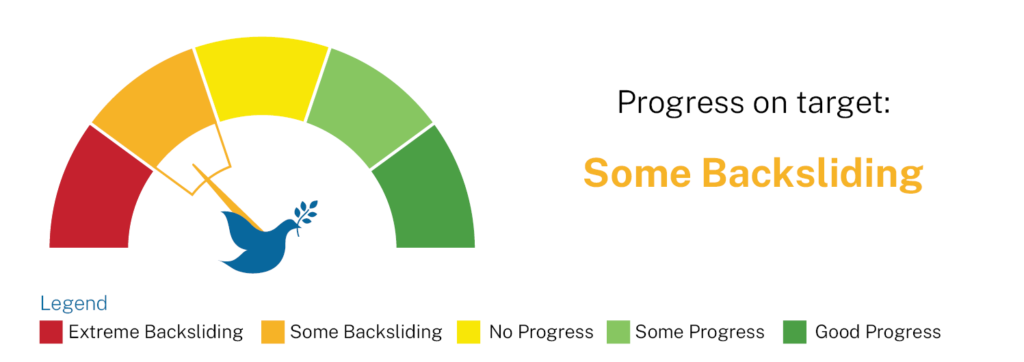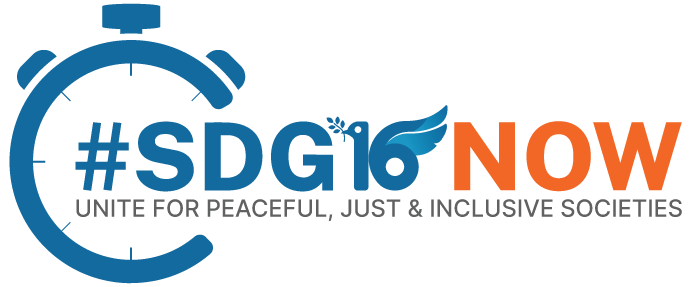Target 16.b: Promote and Enforce Non-Discriminatory Laws and Policies for Sustainable development

There is little official data available, but what little there is reveals that women in particular face high levels of discrimination. Discrimination increased around responses to the pandemic, particularly against poor and indigenous communities.
Authors of chapter

Overview and Interlinkages
The purpose of Target 16.b is to ensure that discrimination does not adversely impact the fair implementation of the Sustainable Development Goals, and to safeguard that ‘no one is left behind’. The United Nations Office of the High Commissioner for Human Rights (UN OHCHR) defines discrimination as “any distinction, exclusion, restriction or preference or other differential treatment that is directly or indirectly based on prohibited grounds of discrimination, and which has the intention or effect of nullifying or impairing the recognition, enjoyment or exercise, on an equal footing, of human rights and fundamental freedoms in the political, economic, social, cultural or any other field of public life.” There are over twenty grounds for discrimination recognised in international law.1
Target 16.b overlaps with SDG16+ Target 10.3, with which it shares a common indicator, and Target 5.c, which also relates to legislation on non-discrimination, 5.1.1 on legal frameworks to promote gender equality, as well as 17.18 on improving the collection of disaggregated data. It is strongly linked with 16.a as National Human Rights Institutions (NHRIs) have the potential to monitor progress and serve as data providers for 16.b and other human rights-relevant targets.
Underpinning the target are numerous international human rights treaties and agreements which prohibit discrimination, including the International Covenant on Economic, Social, and Cultural Rights (ICESCR),2 the International Convention on the Elimination of Racial Discrimination (ICERD), the International Convention on the Rights of Persons with Disabilities (CRPD), the Convention on the Elimination of All Forms of Discrimination against Women (CEDAW), the International Convention on the Protection of the Rights of All Migrant Workers and Members of Their Families (CMW), the United Nations Declaration on the Rights of Indigenous Peoples (UNDRIP), and the International Labour Organisation (ILO) Convention No. 111 on Discrimination in Employment and Occupation.
Progress on indicators
Official Indicators:
- 16.b.1: Proportion of population reporting having personally felt discriminated against or harassed in the previous 12 months on the basis of a ground of discrimination prohibited under international human rights law (Tier II)
Target 16.b is among the few targets that require states to undertake structural measures, such as the enactment of laws and policies. Global Indicator 16.b.1 is a perception indicator that measures people’s experiences of discrimination and can therefore give voice to those experiencing discrimination. However, as a subjective outcome indicator, it does not directly measure the structural element to hold states accountable for their commitments to law reform. As of 2022, official data is only available from around 50 countries.3
According to the UN OHCHR, around 20 per cent of all persons experienced discrimination between 2017 and 2021, with women reporting discrimination twice as often as men and one third of people with disabilities reporting discrimination.4 This was made worse by the COVID-19 pandemic. The World Risk Poll of people in 121 countries found that 21 per cent of people said they faced discrimination in 2021, with the highest based on their nationality and ethnic group.5
Other studies focusing on certain aspects also find a high prevalence of discrimination. The OECD Social Institutions and Gender Index (SIGI), which measures discrimination against women in social institutions across 179 countries, has found that while there is some progress, it will take over two centuries to reach the SDG5 targets at the current rate.6 A 2021 report of 17 countries found that 57 per cent of women reported facing discrimination in their personal, professional and public spheres.7 A study of people in 15 countries with mental illness found that nearly 50 per cent reported discrimination.8
Additional Indicators
This indicator will be challenging to operationalise at a global scale, as people are not necessarily aware of the principles of discrimination under international human rights law. Moreover, the way individuals or groups experience discrimination may reflect ingrained social, cultural, economic patterns that can only change over long periods of time.
Existing global, regional and national human rights mechanisms may provide this missing link. The existence of an independent National Human Rights Institution (NHRI) indicates a State’s commitment to promote and protect human rights set out in international human rights instruments, and is the global indicator for Target 16.a. Given their monitoring mandate and independent status, as well as the focus on non-discrimination and the range of human rights underpinning the SDGs, NHRIs have the potential to monitor progress and serve as data providers for Target 16.b and other human rights-relevant targets.
Another useful data source to monitor Target 16.b are international human rights mechanisms, such as the Universal Periodic Review (UPR) and various treaty bodies including the Committee on the Elimination of Racial Discrimination (CERD) and the ILO Convention 111. These mechanisms provide access to a wide array of data, and therefore, accurate and context-specific monitoring of 16.b. Many recommendations under these mechanisms have direct links to Target 16.b, as illustrated in a 2016 report, which explicitly links Denmark’s most recent Universal Period Review (UPR) recommendations to the SDGs.9 Progress towards Target 16.b can therefore be measured by the number and extent to which recommendations under the various mechanisms are actioned or left pending. The same human rights mechanisms are also well placed to report on whether recommendations related to discriminatory policies and legislation have been addressed or remain outstanding, thus contributing to a fuller picture of the progress towards Target 16.b.
Recommendations
- States should create easily accessible and safe mechanisms for people to report cases of discrimination.
- In collaboration with NHRIs, National Statistical Offices should undertake representative surveys using the proposed methodology.
- Citizen-generated data should be used as an additional source of information for monitoring the level of discrimination.
